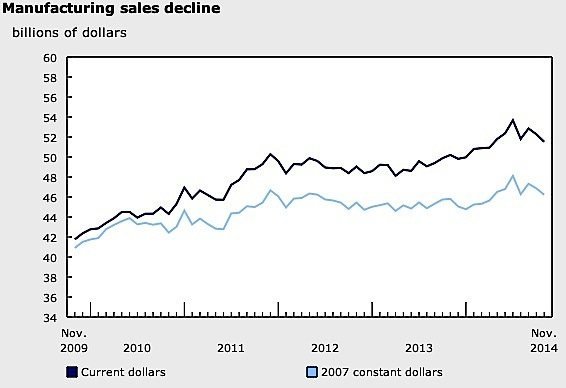Despite declining by 1.4 per cent in November, Canada’s manufacturing sales for the first eleven months of the year remain 5.2 per cent higher than for the same period last year. Statistics Canada reports that sales were down in sixteen of the twenty-one industries it tracks. The total value of sales in November was $51.5 billion. A decline of about 0.7 per cent had been expected, according to analysts.
One of the big losers in November was the auto sector. Sales fell 5.9 per cent to $4.6 billion after “widespread decreases.” The drop was enough to offset gains made in the previous two months and send the auto sales numbers 10 per cent lower than the two-year high reached last July.
Declines were seen for the fourth consecutive month by chemical manufacturers (- 3.6 per cent). The primary metal industry lost 3 per cent after a 5.4 per cent drop in October, with November sales nevertheless reaching $4 billion, where they have remained for more than two years now.
Food manufacturing fell 1.3 per cent, after three months of gains.
An increase of 9.1 per cent in the production of aerospace products and parts was enough to partially offset the other declines, Statistics Canada says. The gains in the aerospace industry were due in part to the drop in the value of the Canadian dollar.

Ontario, where most of Canada’s manufacturing is centred, saw sales fall 2.1 per cent in November, to $23.7 billion. It was the third month in the last four to record a decline, led by the fall in auto sales and chemicals. Still, on a year-to-date basis, Ontario’s manufacturing sales were 5.8 per cent higher than for the first eleven months of 2013.
The Canadian dollar fell around 1 cent on the manufacturing news. The drop in the loonie could ultimately be good for manufacturers, however. A CIBC World Markets report last week points out that while a lower loonie is generally good for Canadian manufacturers, there will be a significant lag between a falling dollar and new investment in the factory sector. The dollar will have to remain at around 80–90 cents for several years before any benefits are seen, the report says. Some financial analysts expect to see the loonie rise to 87 cents by the end of 2015.
Unfilled orders were up by 0.2 per cent, to $91.1 billion in November. It was the fourth increase in five months and reflected higher orders in the machinery industry, particularly the engine, turbine and power transmission equipment sub-industry, and agricultural, construction and mining machinery.



































